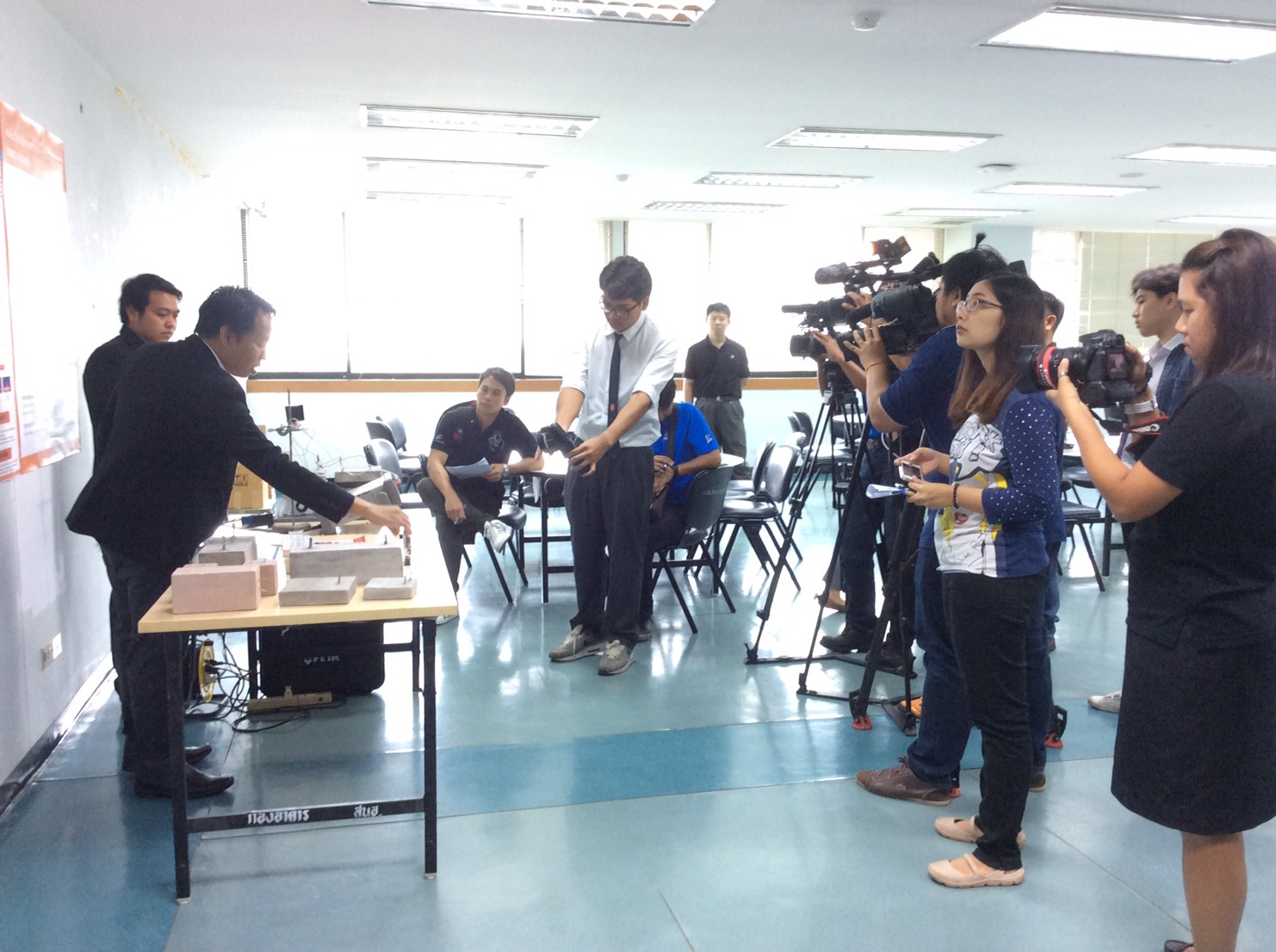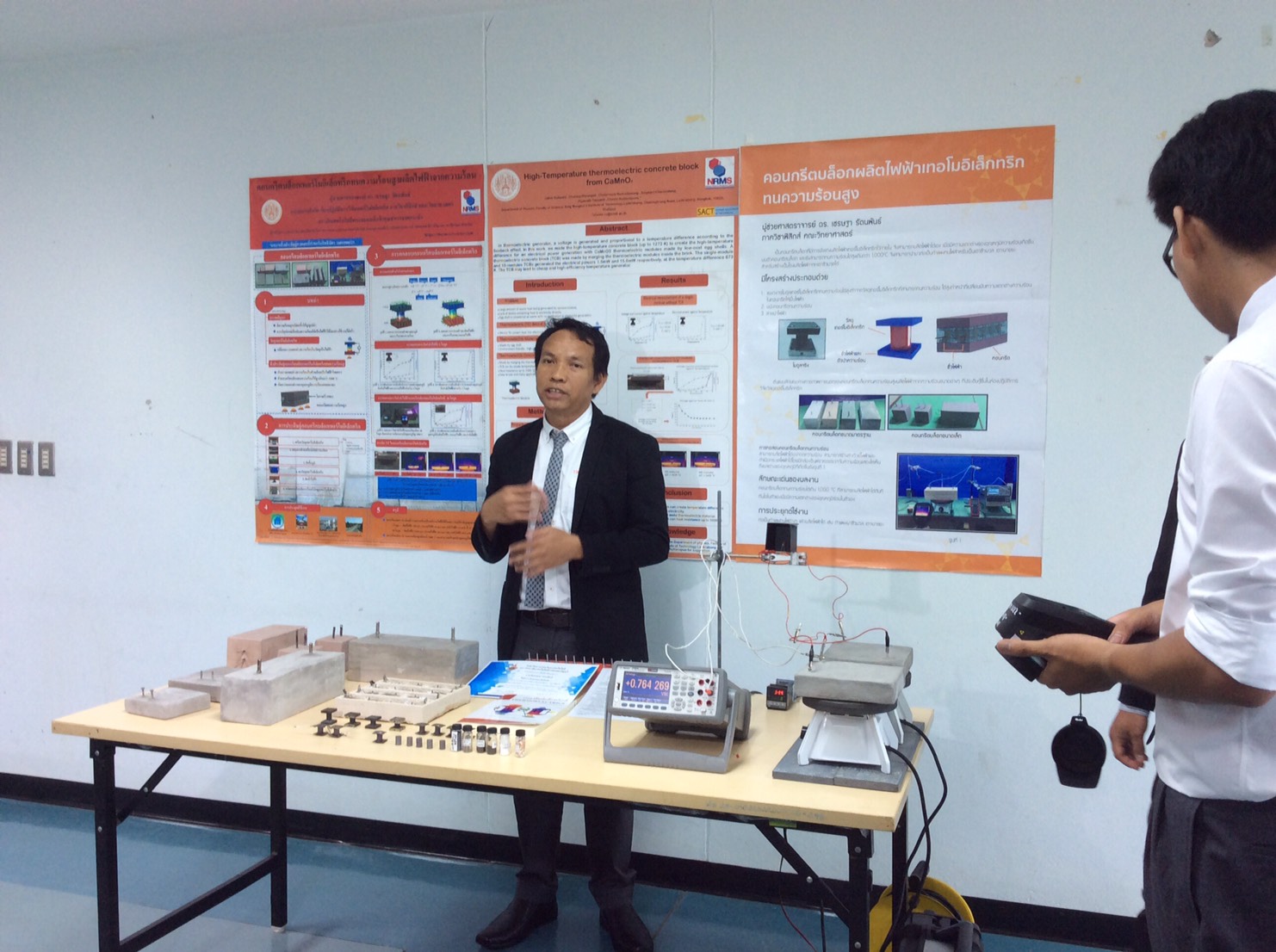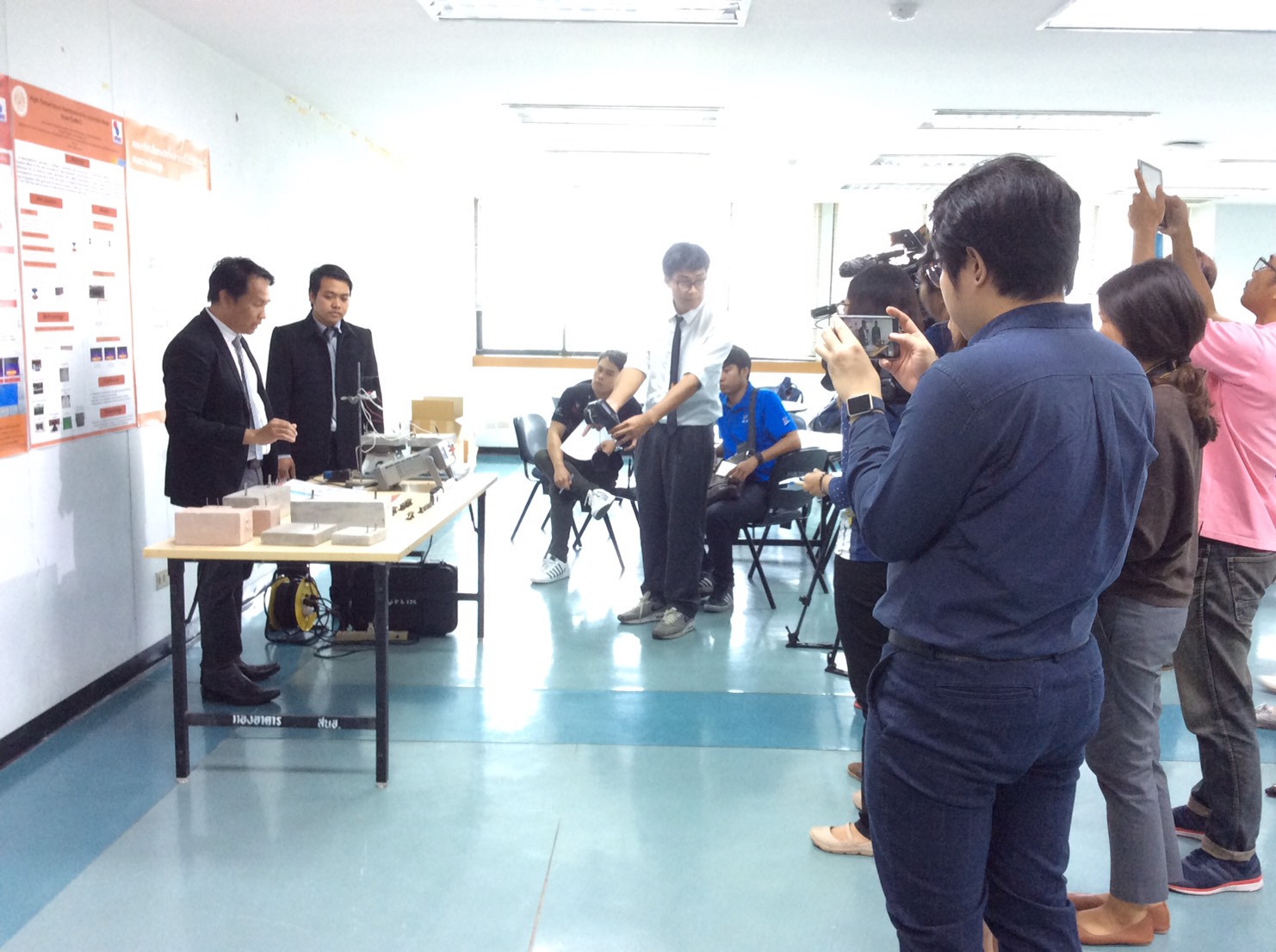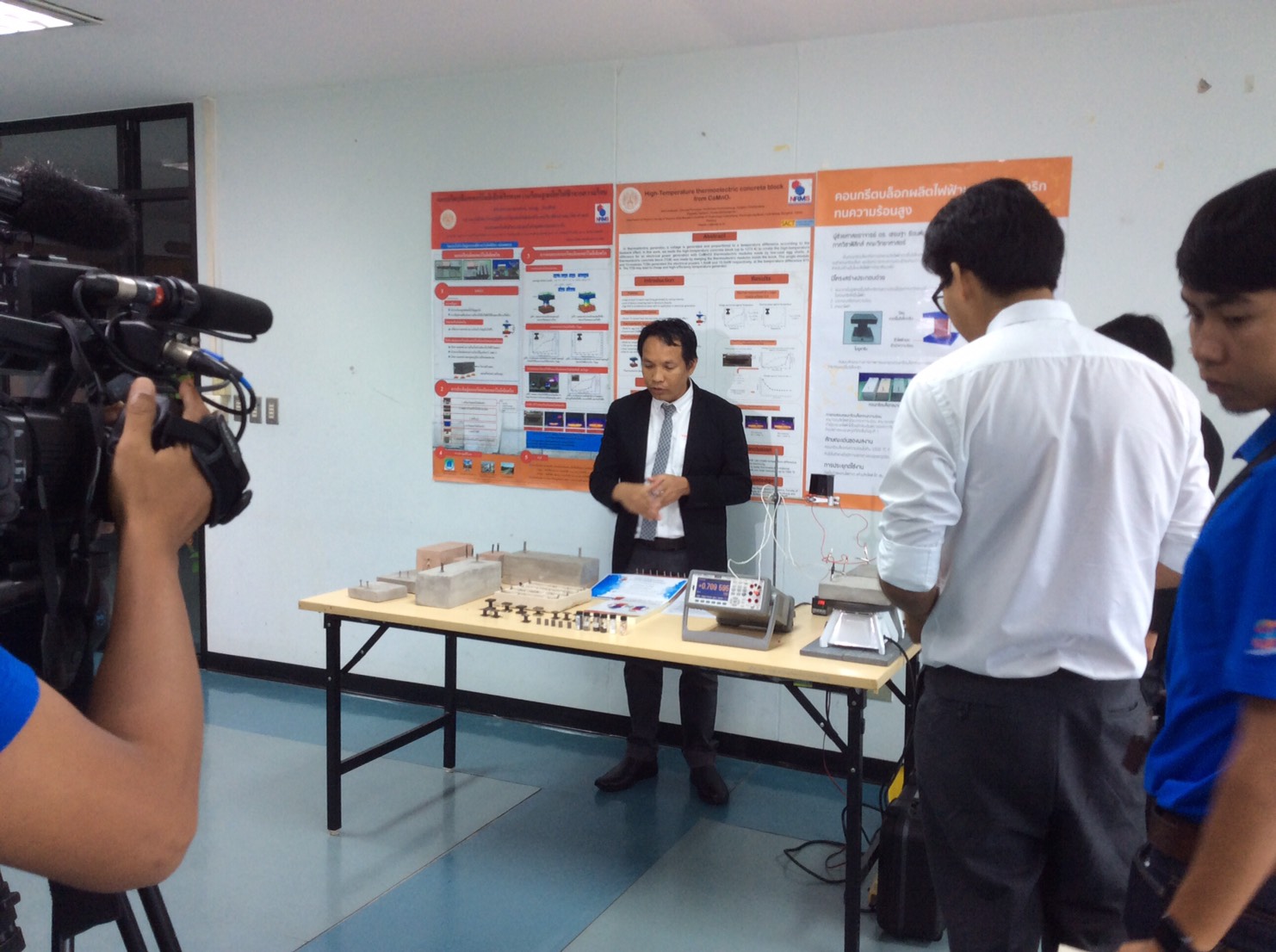“High temperature resistant brick capable of producing power”

A team of KMITL researchers has successfully used eggshells to produce a “high temperature resistant brick capable of producing power” for the first time in the world.
KMITL has developed a new invention which is able to recycle waste heat from furnaces, biomass stoves and large incinerators, and convert it into electrical power. Inthe future, KMITLwillusethis inventionin designing concrete walls and power-generating roofs for smart homes and in constructing power-generating roads.
Bangkok, 29 June 2016— A team of physicists from the Faculty of Science, King Mongkut’s Institute of Technology Ladkrabang (KMITL) has succeeded, for the first time in the world, in developing “a high temperature resistant thermoelectric concrete block which uses eggshellsas a substrate.” The brick was engineered to withstand temperaturesof more than 1,000 degrees Celsius and equippedwith an embedded power generator called the“thermoelectric module” inside, produced from calcium oxide extracted from eggshells and capable of withstanding temperatures up to 900 degrees Celsius. This engineered brick can be used not only to build firewalls, but also to generate electrical power for thermal industries whose waste heat from furnaces, biomass stoves and incinerators can be recycled and converted into power. KMITL plans to develop this thermoelectric module by incorporating it into power-generating walls and roofs built for smart homes and by employing this innovation in constructing power-generating roads.
Assistant Professor DrChestaRuttanapun, a researcher atThermoelectric Research Laboratory, Department of Physics, Faculty of Science, King Mongkut’s Institute of Technology Ladkrabang (KMITL) and an advisor to “a high temperature resistant thermoelectric concrete block which uses eggshells as a substrate” project, says that colleges and universities around the world are now placing great emphasis upon developing green innovation and technology. KMITL, as one of leading science and technology institutes,fully supports research intoenergy efficiency and green innovation. The research team behind the thermoelectric concrete block also includes ChaiwatPromphet, a PhD candidate, and ChakritKobphan, an undergraduate student, both from the Department of Physics, KMITL. Together, they have developeda brick which is capable of withstanding temperatureshigher than 1,000 degrees Celsius andconverting temperature difference of around 400-900 degrees Celsius into electric voltage; this makes this brick the first one in the world to possess such capacities. A patent application is now in process.
Assistant Professor DrChestaRuttanapunexplains that the high temperature resistant thermoelectric concrete block is a new design and that the designing process had two stages. The first stage involved designing a high temperature resistant brick which was engineered by the research team to withstand temperatureshigher than 1,000 degrees Celsius, and the second stage involved creating a power generator to be embedded inside the brick. The research team had developed “thermoelectricmaterial” by extracting calcium oxide from eggshells.Calcium oxide is an important chemical forcreating the power generator inside the brick,called the“thermoelectric module,” which is capable of withstanding temperatures higher than 900 degrees Celsius. As two sides of thebrick sustain different levels of temperature; i.e., the temperature of one side ofthe brick is higher than the other side, this temperature difference affectsthethermoelectric module which consists of 10 thermoelectric devices and which is embedded inside the brick, resulting in a movement of electrical charge. As an experiment showed, two thermoelectric concrete blocks connected in a serieswere able to sufficiently supply power for a 105mW LED lightbulb when the temperature of these bricks reached 600 degrees Celsius. When used in constructing a furnace, 6,000 thermoelectric concrete blocks will be able to produce 1.2 kW-6kW of electrical power. The size of concrete blocks and the number of modules need adjustment when used as a power generator using thermal energy from other sources
“Sincethe high temperature resistant thermoelectric concrete block is new in Thailand, the manufacturing costs and profits are yet to be precisely determined. When compared to normal fireproof concrete blocks available on the market which, depending on their heat resistance capacity, cost from 100 to 700 Baht, these engineered thermoelectric concrete blocks are likely to be 2 to 4 times more expensive.Although high temperature resistant thermoelectric concrete blocks are more expensive, they are worth the money since they are embedded with a power generator which is able to converttemperature difference of around 300-900 degrees Celsius into electric voltage, and they are equipped with electrodeand conductor materials which are capable of withstanding temperatures of more than 1,000 degrees Celsius. They can be used to build furnaces, biomass stoves and large incinerators. In the future, when these engineered bricks are developed commercially, the cost is likely to be lower.”
“A high temperature resistant thermoelectric concrete block which uses eggshells as a substrate” was awarded the second prize in the Physic Division of the Tertiary Research Project Competition which was held on May 30, 2017. A contract to develop this brick is soon to be signed with Research and Researchers for Industries (RRI) by Thailand Research Fund (TRF). Thermoelectric material is also being developed to be able to convert temperature difference of the sunlight, so that this material can be embedded in walls or roofs, thereby generating power for smart homes. Power-generating roads will also be made possible in the future. And the thermoelectric material will be further developed so that it can convert temperature difference into higher electrical voltage,” adds Assistant Professor DrChestaRuttanapun.
ChaiwatPromphet, a PhD candidate, at the Department of Physics, Faculty of Science, KMITL, mentions an important technique that makes the brick resistant to high temperatures and capable of producing power. The brick is made as a “fireproof concrete brick” so that itcan withstand high temperatures and transfer heat to the power generator embedded inside, and as a “heat concrete brick” so that heat can be stored and power can be generated subsequently as the temperature difference occurs. This engineered brick then has an oxide-based thermoelectricmaterialembedded inside, designed to be compatible with temperature difference occurring inside the brick. The brick with an oxide-based thermoelectric material is then equipped with electrode and conductor materials capable of withstanding more than 1,000 degrees Celsius, and then the brick is able to generate consistent power output.
ChakritKobphan, an undergraduate student, at the Department of Physics, Faculty of Science, KMITL, adds that thethermoelectric material, which is instrumental in creatingthe power generator called “the thermoelectric module,” uses calcium oxide 99% as a substrate, and this chemical costs 1,500-2,000 Baht per kilogram. Since calcium oxide can be extracted from eggshells, eggshell wastes collected from the Faculty of Science canteen were brought into a lab and had calcium oxide extracted from them. This is the way to decrease the import of calcium oxide and reduce waste. Not only is the cost of the product reduced but also good image is established for the product. Nowadays, thermoelectric modules which are capable of converting temperature difference of around 100 degrees Celsius into electric voltage cost 500 Baht. They are cheap, but they are unable to withstand temperatures of more than 200degrees Celsius. Those which can withstand temperatures between 300-600 degrees Celsius are priced around 3,000-5,000 Baht. Those which can withstandtemperatures of more than 500 degrees Celsius are very expensive, as the materials used to create these thermoelectric modules must be very endurable and technologically advanced. Therefore, using calcium oxide extracted from eggshells will save cost. If developed further, the thermoelectric modules may be 3 times cheaper than those available on the market now.
Professor DrSuchatveeSuwansawat, the president of King Mongkut’s Institute of Technology Ladkrabang (KMITL), says that in addition to “a high temperature resistant thermoelectric concrete block which uses eggshells as a substrate” project, KMITL has supported and facilitated research and innovation of renewable and alternative energy in anattempt to achieve energy sufficiency. This attempt has been realised in the construction of the Smart Electrical Building which is used as a solar cell learning centre and as a workshopfor engineering students so thatthey could learn from real technologies. A plan to builda prototype of the solar house with an architectural design that allows residents live in harmony with nature is also supported by KMITL. In addition, as part of the 2015-2019 Masterplan for KMITL Development, KMITL plans to become a green campus, and policies are also set to support and facilitateresearch and innovation on renewable and alternative energy.
For more details, please contact the Public Relations Division, King Mongkut’s Institute of Technology Ladkrabang. Tel: 02-329-8111, Email: www.kmitl.ac.th
 Login
Login


